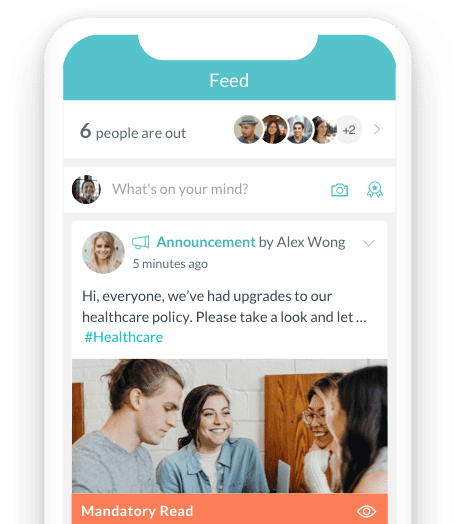How to Build a Well-Connected Healthcare Team



 Cut onboarding time
by 60%—here's the
Ultimate Checklist
that helped do it.
Cut onboarding time
by 60%—here's the
Ultimate Checklist
that helped do it.

To become a doctor, medical students must take the Hippocratic Oath—a code of ethics exemplified by the “first, do no harm” principle.
What this means in the 21st Century is that patient health and wellbeing are at the core of what medical professionals do. Doctors, nurses, and healthcare management staff are all bound by a duty of care to provide their patients with the best possible service possible.
Earning an MBBS degree equips medical professionals with the comprehensive knowledge and skills essential for delivering high-quality healthcare, encompassing the diagnosis, treatment, and prevention of diverse medical conditions.
But how can this be guaranteed? What areas must healthcare managers focus on to deliver on their promise?
The Fundamentals of a Well-Connected Healthcare Team
For starters, you must hire qualified staff, install adequate facilities and software (see: modernization of mainframe), and be well-stocked on medical equipment and supplies. However, these individual elements are useless without the binding glue that is communication. You must also focus on building a well-connected healthcare team and supporting infrastructure.
Effective communication among healthcare team members is essential for providing high-quality patient care, improving patient outcomes, and enhancing the overall healthcare experience. It also improves the wellbeing and job satisfaction among staff members and can improve employee performance.
In this blog post, we'll explore the key factors that contribute to building a well-connected healthcare team that prioritizes communication and collaboration.
Why Communication Matters in Healthcare Settings
Picture this scenario: a patient with a chronic illness visits a hospital for a check-up. The patient is greeted by a nurse who takes their vitals and asks them a series of questions about their symptoms. After waiting for what seems like an eternity, the patient is finally seen by a doctor who orders some tests and prescribes a medication.
Days go by, and the patient's symptoms persist. They return to the hospital, only to be seen by a different doctor who has no idea about their medical history. If this happened to you, I expect you would be left feeling frustrated and confused. Yet, this is the reality for healthcare settings in which communication has broken down.
At its worst, failure to communicate can have disastrous consequences for patient outcomes. In fact, a study found communication failures to be an issue in 49% of malpractice claims.
Imagine if a patient was misdiagnosed due to a lack of clarity about their symptoms or an operation went wrong because notes were misinterpreted. This could put the doctors and nurses at risk of facing a negligence lawsuit and would destroy confidence in the healthcare facility’s services.

6 Steps for Building a Well-Connected Healthcare Team
As with any industry or project, creating a well-connected team is no easy feat. It can take months of planning, implementation, and problem solving before improvements are noticed, and even when action plans are running as intended, it can be a largely thankless endeavor.
That should not deter you from putting the effort in and the many benefits that will follow. Here are six steps that your healthcare team can follow to ensure communication is immediate and reliable:
Define Roles and Responsibilities
The first step is to clearly define each team member’s expected roles and responsibilities. Then, everyone will have a clear understanding of the processes for patient treatment, and management will gain visibility of “pain points” if this framework ever breaks down.
To execute this process correctly, you must determine the scope of practice for each role, e.g., physicians, nurses, and specialist professionals. Next, you must consider the specific responsibilities associated with each role.
For example, a physician might be responsible for diagnosing and treating patients, while a nurse might be responsible for administering medication and monitoring vital signs. These can be further broken down into detailed job descriptions.
Adopt Clear Communication Strategies
Now that you know what the roles and responsibilities of each team member are, you must consider how they interact with one another and work as a team.
The first step is to create protocols/procedures that must be followed as part of a role’s checklist of responsibilities. This should cover everything from patient intake and assessment to treatment plans and discharge instructions. You should invest significant time into training team members on their ‘reporting relationships’—ensuring they know who to report to and who is responsible for managing their work.
Finally, you should focus on optimizing your communication channels by identifying bottlenecks. For instance, your receptionist may be responsible for directing incoming calls to relevant team members. However, this process may be undesirable for internal comms, especially if their phone lines are overloaded with callers. Rather, you may want to use a direct routing feature or a similar VoIP service to improve their performance.

Foster Collaboration and Teamwork
You may have heard a saying that “the fish rots from the head down.”
In workplace settings, this is used as a metaphor for leadership—that management is usually the root cause of an organization’s failure. It follows that communication strategies must be established and strictly adhered to by managers themselves, setting a role model for their wider teams and company culture.
Other tips for promoting a positive and supportive workplace culture include encouraging a healthy work-life balance, hosting social events, fostering employee engagement, and rewarding individual successes.
Encourage Professional Development
The next step is to encourage continuous professional development among your healthcare staff, for instance, by providing feedback and constructive criticism or hosting regular training sessions. After all, the better the employee experience and the more invested they are in their future at a company, the more they will strive to develop their skills and deliver top-quality service.
Failure to foster a positive workplace culture will send the wrong message to your staff and patients. It gives the impression that you have low expectations for one another and for the overall service, creating a poor work environment. Consequently, your team is steered in the wrong direction—toward a service that delivers the bare minimum and where staff are not challenging themselves.

Introduction to Conflict in the Workplace
(and How it Erodes Productivity & Culture)
Address Conflicts and Challenges
Anyone who has worked in a team setting will have encountered barriers to communication.
For instance, you may have team members who speak different languages, have limited knowledge of technology, or just plain dislike each other! As a manager, it is your job to identify these challenges and come up with effective solutions.
When dealing with conflict, you should do so transparently—ensuring that each party is aware of their expectations, and setting an example for others to follow.
You can also utilize things like discussions in team meetings, employee pulse surveys, and annual engagement surveys as ways of measuring employee engagement over the short and long term.
Pulse survey questions can offer immediate insight into issues troubling your workforce, such as insufficient training or disagreeable work hours. Just be careful not to overuse these tools, or your staff could end up with survey fatigue.
Utilize Technology and Tools for Team Building
Your communication channels are only as strong as the infrastructure that underpins them.
Legacy technology such as emails or telephones may be familiar to your staff, but they are rapidly being replaced by enterprise communication solutions. These platforms require some basic training to get started, but once up and running, they can help you share practice policies much faster. They also consider the legal implications of handling sensitive data (like patient or employee details) by adhering to GDPR and HIPAA regulations.
Team Building as The Key to Providing Excellent Patient Care
Team building is a crucial factor in how healthcare environments provide a high standard of care to patients. When medical teams work effectively together, they can improve patient outcomes, reduce the risk of errors and negative feedback, and increase overall patient satisfaction.
Beyond that, teams collaborating and providing mutual support will likely retain employees and enjoy increased professional development. As such, building a well-connected healthcare team is at the forefront of any medical facility’s priorities if they are to succeed.
Find Out How Much You Can Save by Switching to Workmates.
and save upwards of 60%

Author Bio:
This article is written by a marketing team member at HR Cloud. HR Cloud is a leading provider of proven HR solutions, including recruiting, onboarding, employee communications & engagement, and rewards & recognition. Our user-friendly software increases employee productivity, delivers time and cost savings, and minimizes compliance risk.
Keep Reading
15 Proven Ways to Create a Healthy Work Environment (2026 Guide)
A healthy work environment is a workplace where employees experience psychological
Best Workday Alternatives for Mid-Market Companies in 2026: Complete HRIS Comparison Guide
"We implemented Workday and our HR team still can't figure out half the features six
Company Culture Software: How to Build a Thriving Workplace in 2026
Ask any business leader what drives lasting organizational success, and you'll hear
Like What You Hear?
We'd love to chat with you more about how HR Cloud® can support your business's HR needs. Book Your Free Demo

Build a Culture of Recognition. Boost Engagement. Guaranteed.
Workmates empowers employees to stay informed, connected, and appreciated—whether they’re on the front line, in the office, or remote. Recognition drives 12x higher engagement.Trusted by industry leaders in every sector




Cut Onboarding Costs by 60%.
Take the confusion and follow-ups out of onboarding with automated workflows, digital forms, and structured portals—so new hires ramp faster 3X quicker.Trusted by industry leaders in every sector






